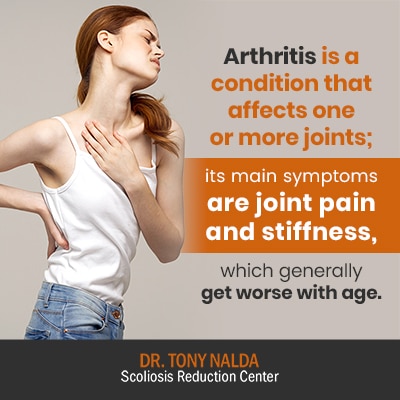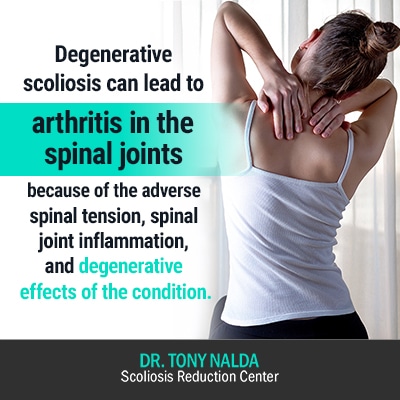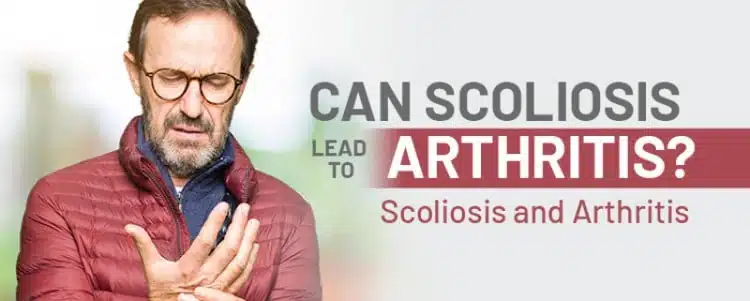As scoliosis is a spinal condition characterized by an abnormal spinal curvature, it can affect the spine’s overall health and biomechanics in numerous ways. Scoliosis can also lead to the development of a number of related conditions, especially if left untreated.
Degenerative scoliosis is caused by the degenerative effects of aging on the spine; osteoarthritis, the most common form of arthritis, can share the same degenerative process. Degenerative scoliosis can lead to osteoarthritis by causing spinal joint inflammation and introducing adverse spinal tension.
Before we get into how scoliosis can lead to the development of multiple spinal conditions such as spinal stenosis, bone spurs, and arthritis of the spine, let’s first take a look at the basics of scoliosis and arthritis.
The Basics of Scoliosis
Scoliosis is the leading spinal condition amongst school-aged children in the United States. The National Scoliosis Foundation estimates that there are close to seven million people currently living with the condition in the States. Also, keep in mind that these numbers only reflect ‘known’ diagnosed cases.
When a person is diagnosed with scoliosis, this means that their spine has an abnormal spinal curvature. The spine is naturally curved, but it can also develop bad curves, such as when one of the healthy curves become under- or over-pronounced.
For a person to receive a scoliosis diagnosis, their spine has to have an abnormal curvature with a minimum Cobb angle measurement of 10 degrees, plus rotation.
A patient’s Cobb angle is a measurement obtained from X-ray images that determine how far out of alignment a scoliotic spine is; it does this by drawing intersecting lines from the tops and bottoms of the most-tilted vertebrae (bones of the spine) in the curvature.
The condition’s most common form is adolescent idiopathic scoliosis (AIS), diagnosed between the ages of 10 and 18, with no single-known cause, accounting for 80 percent of known diagnosed cases. The remaining 20 percent are atypical forms with known causes such as neuromuscular, congenital, degenerative and traumatic.
We’ll return to this later, but in the context of arthritis, it’s degenerative scoliosis that we will be focusing on.
Scoliosis is a progressive condition, meaning it’s in its nature to worsen over time. This is why proactive treatment is so crucial for scoliosis patients; we want to help patients avoid the hardships associated with increasing condition severity.
While every case is different and ranges from mild to moderate and severe to very severe, common scoliosis symptoms of varying severity levels include:
- Noticeable spinal curvature
- Uneven shoulders with one sitting higher than the other
- Uneven shoulder blades with one protruding more than the other
- Uneven hips
- Presence of a rib arch
- Uneven waistline
- Arms and legs that seem to hang at different lengths
- An overall lean to one side when standing
- Changes to gait
- Balance/coordination issues
- Pain (in adults)
As you can see, the most noticeable visual scoliosis symptoms are postural changes that give the body an overall asymmetrical appearance; this is because there are a lot of uneven forces at work with the condition. In adults, it’s more so pain that is noticed and leads to a diagnosis.
Now that we have covered the basics of scoliosis, let’s move on to exploring the defining features of arthritis.
The Basics of Arthritis

Arthritis is a condition that affects one or more joints; its main symptoms are joint pain and stiffness, which generally get worse with age.
There are two main types of arthritis: osteoarthritis and rheumatoid arthritis.
Osteoarthritis
Osteoarthritis is the most common type of arthritis and involves the cartilage that covers the ends of bones, where a joint forms.
Cartilage provides cushioning for the ends of bones and facilitates frictionless joint motion. When the cartilage is broken down, it can result in bones grinding directly against each other, learning to pain and impaired movement.
Osteoarthritis, while it involves the joint’s cartilage, impacts the entire joint. It causes changes inside the bones and deteriorates the connective tissues that connect muscle to bone and helps to hold joints together. It’s also known to cause the joint lining to become inflamed.
Rheumatoid Arthritis
In a person living with rheumatoid arthritis, the body’s immune system is attacking the joint capsule’s lining: durable membrane that surrounds the parts of the joints, enclosing them.
As a result, the lining (synovial membrane) becomes swollen and inflamed. The path of the disease can gradually destroy the joint’s cartilage and bone within.
While there are many different types of arthritis that can develop, along with different types of symptoms, the most common arthritis symptoms include:
- Pain
- Stiffness
- Redness
- Inflammation
- Impaired range of motion
Now that we have explored the basics of scoliosis and the main types of arthritis, let’s take a look at the potential connection between the two.
Scoliosis and Arthritis
So what is the connection between scoliosis and arthritis? The thing to remember is that scoliosis is progressive, meaning the early days of scoliosis progression can be very different from the later stages, in terms of severity and potential complications.
If scoliosis is left untreated, or in particularly severe forms, the chances of developing complications and/or the development of related conditions, such as spinal osteoarthritis, increases.
While every case has its own progressive rate, and there are certain indicators we look for to help us predict a patient’s likeliest rate of progression, there is no definitive means by which we can fully predict how fast, or slow, a person’s scoliosis is going to progress; we do know, however, that every case will progress at some point.
This is why, here at the Scoliosis Reduction Center®, we believe proactive treatment should be started as close to the time of diagnosis as possible. Not only can early detection and treatment lead to a better outcome, we also want to limit the chances of patients experiencing scoliosis-related complications, such as the development of other spinal conditions.
Now, as we discussed, AIS is the condition’s most common form, but adults can develop scoliosis as well. It’s adults with scoliosis who are already facing the potential effects of age-related spinal degeneration, plus the cumulative effect of certain lifestyle choices, that are at the highest risk of developing arthritis of the spinal joints.
Scoliosis in Adults
While there are different types of scoliosis adults can develop, the two most common forms are idiopathic and degenerative.
Idiopathic Scoliosis in Adults
In cases of adults with idiopathic scoliosis, these are cases of AIS that progressed into maturity. This can seem hard to understand, but many cases of AIS don’t produce noticeable symptoms until skeletal maturity has been reached.
In these types of cases, the scoliosis that might have started in the mild stage of progression as a small curvature in adolescence, has been allowed to progress unimpeded into maturity; by the time these people come to see me, their scoliosis has progressed significantly.
It’s most often pain that leads adults to a scoliosis diagnosis as the compression caused by the abnormal curvature does not have growth to counteract it, as younger patients do, which is why scoliosis often not painful in children and adolescents.
Degenerative Scoliosis in Adults
In degenerative scoliosis, the spine has experienced degeneration due to aging, plus the cumulative effect of certain lifestyle choices, and it’s this form of scoliosis that most commonly leads to the development of arthritis in the spinal joints.
As a person ages, the degenerative effects can be felt throughout the body, including the spine; most commonly, it’s the spine’s intervertebral discs that are affected.
When it comes to lifestyle choices that can impact the health of the spine as it ages, we are talking about maintaining a healthy weight, staying active, practicing good posture, and making sure to lift heavy objects properly without straining the back.
The bones of the spine (vertebrae) are stacked on top of one another, separated by intervertebral discs that play important roles: making the spine flexible, cushioning the vertebrae so they don’t rub against each other, providing the spine with structure, and helping to maintain the spine’s healthy curvatures.
When discs and joints face degenerative changes, it can cause spinal stenosis: narrowing of the spine’s spinal canal that houses the spinal cord. This narrowing puts excess pressure on the spinal cord, which can cause numbness, weakness in the affected area, and/or numbness.
In addition, once skeletal maturity has been reached, as is the case with adults, the compression caused by the curvature is felt by the spine and its surrounding muscles, vessels, and nerves; this can cause varying levels of back and radiating pain.
When degenerative scoliosis is present, it introduces adverse spinal tension and spinal joint inflammation, known to disrupt the spine’s health and biomechanics. Once this happens, the spine’s ability to maintain its natural and healthy curvatures is compromised, potentially leading to the development of spinal stenosis and arthritis in the spinal joints.
Arthritis of the Spine
The painful symptoms of degenerative scoliosis are comparable to lumbar (lower back) degenerative disc disease and lumbar osteoarthritis of the spine; this is because they share the same degenerative process.

Degenerative scoliosis can lead to arthritis in the spinal joints because of the adverse spinal tension, spinal joint inflammation, and accelerated degenerative effects of the condition.
Some of the painful symptoms shared by degenerative scoliosis and spinal osteoarthritis include:
- A dull ache and/or stiffness in the middle to lower back
- Loss of spinal flexibility
- Irritated nerves
- Sciatica
- Sensation of tingling and/or numbness that radiates down the buttocks, into the leg
- Sharp leg pain that is worse while walking, but can subside with rest
Osteoarthritis can also lead to the formation of bone spurs. While the name might conjure up images of jagged bony fragments, bone spurs are smooth growths of bone that can form slowly over long periods of time; they are normal bone growths that can accompany aging.
While the spurs themselves are not known to cause pain, the pressure they can exert on nearby structures, such as the spinal cord and nerves, can cause varying levels of discomfort and pain.
So can scoliosis lead to arthritis? Yes, it can, but not necessarily for everyone. Scoliosis introduces so many uneven forces to the spine that uneven wear and tear occurs; the spine and its nearby structures feel the effects of struggling to support and stabilize a spine that is abnormally curved.
As scoliosis can speed up spinal degeneration and cause spinal joint inflammation, this can lead to the development of spinal stenosis, bone spurs, and arthritis of the spinal joints.
Conclusion
As such a complex and crucial element of anatomy, the spine can develop a wide range of conditions; scoliosis is a highly-prevalent spinal condition with the potential to cause additional related spinal conditions to develop, such as spinal stenosis, bone spurs, and arthritis in the spinal joints.
When scoliosis is present, and especially when left untreated, the condition can change the function of the vertebra’s facet joints, making movement problematic as it makes these joints more susceptible to stress and friction, increasing the likelihood of developing osteoarthritis of the spine.
While there are two main forms of arthritis, osteoarthritis and rheumatoid arthritis, scoliosis is more closely linked to osteoarthritis as this form shares the same degenerative process as in degenerative scoliosis.
The important thing to remember about scoliosis is that as a progressive condition, its very nature is to worsen over time. Just as the degenerative effects of aging and lifestyle choices made over the years have a cumulative effect on spinal health, the effect that scoliosis can have on the function and health of the spine is significant, especially when left untreated.
If scoliosis is caught early, say through a person noticing symptoms at home or during a routine physical examination, our patients get the benefits of early detection through the implementation of proactive treatment.
Here at the Scoliosis Reduction Center®, we believe in proactive functional treatment so we can work towards a structural curvature reduction; this doesn’t just result in making the abnormal spinal curvature smaller, it also improves the overall health and function of the spine.
By restoring as much of the spine’s healthy curves as possible, we are decreasing the chances of developing related complications and conditions such as spinal stenosis, bone spurs, and osteoarthritis of the spine.





